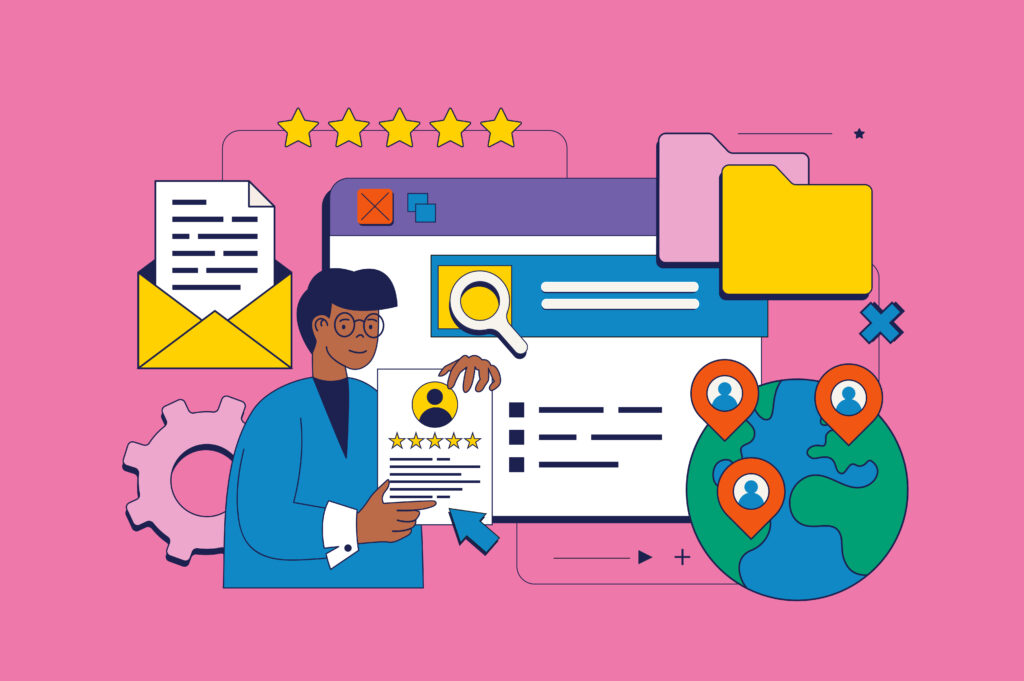Running a small business today can feel like a David vs. Goliath battle. Large enterprises have seemingly endless resources and access to cutting-edge technology. But what if the secret weapon to compete wasn’t size, but smart software solutions? SaaS (Software as a Service) is revolutionizing the way small businesses operate, offering access to powerful tools previously reserved for large corporations.
Let’s explore how these solutions can level the playing field and empower you to compete effectively.
What is SaaS?
Software-as-a-Service (SaaS) is a cloud-based method of delivering software applications to users over the internet. In this model, users subscribe to access applications rather than purchasing and installing them locally.
SaaS solutions run on the provider’s servers, and the provider manages access, security, availability, and performance. This model eliminates the need for upfront hardware and software investments, reduces IT burdens, and offers flexible payments, scalability, and automatic updates.
How SaaS Differ From traditional Software?
SaaS solutions differs from traditional software in several key aspects:
- Delivery: SaaS is accessed online through a web browser, while traditional software needs to be installed on your device.
- Cost: SaaS uses a subscription model, often with pay-as-you-go options. Traditional software requires a one-time upfront purchase.
- Updates: The provider handles updates and maintenance in SaaS, while you’re responsible for them with traditional software.
- Customization: SaaS offers some customization, but less than traditional software you can directly modify.
Why do SaaS Solutions Make Sense for Small Businesses?
SaaS solutions are ideal for small businesses because they require minimal upfront costs, offer pay-as-you-go pricing models, and eliminate the need for expensive hardware and IT staff. With SaaS, small firms can access enterprise-grade applications and cutting-edge technology that would otherwise be unaffordable.
Additionally, SaaS providers handle software updates and maintenance, allowing small businesses to focus on their core operations while benefiting from the latest features and security updates.
How can a SaaS Model Benefit a Small Business with Limited Resources?
Small businesses with limited resources can find SaaS solutions to be a game-changer for several reasons:
- Cost-Effectiveness: SaaS eliminates the high upfront costs of traditional software licenses and expensive hardware upgrades. Subscription models allow for predictable monthly expenses that fit your budget.
- Reduced IT Burden: SaaS providers handle software maintenance, updates, and security, freeing up your limited IT staff to focus on other critical tasks.
- Scalability & Flexibility: Easily scale your SaaS usage up or down as your business grows, avoiding the need for costly software overhauls. Only pay for the features and users you need.
- Rapid Implementation & User-Friendliness: SaaS solutions often require minimal setup and boast intuitive interfaces, allowing your team to get up and running quickly without extensive training.
- Access to Advanced Features: SaaS offers access to powerful features and functionalities that were once out of reach for small businesses due to cost or complexity.
- Improved Collaboration & Mobility: Cloud-based SaaS allows your team to access tools and data from anywhere, anytime, fostering remote work and collaboration across locations.
How can SaaS Help You Scale Your Business Saster and Cheaper?
SaaS fuels faster and cheaper scaling for businesses by offering:
- Pay-as-you-go model: No massive upfront costs for software licenses or hardware upgrades.
- Instant Scalability: Easily adjust your software usage (and cost) as your business grows.
- Automated Operations: Free up IT resources by eliminating software maintenance and updates.
- Data Insights: SaaS programs offer robust analytics and reporting for data-driven optimization.
- Focus on Growth: Invest time and energy in core business activities, not software headaches.
Most Common SaaS Types for Small and Medium Businesses
SaaS applications are available for almost every business function, including:
- Customer Relationship Management (CRM): Cloud-based CRM tools help businesses manage customer data, sales pipelines, and customer interactions more effectively.
- Project Management: Project management tools facilitate collaboration, task assignment, and progress tracking for teams working on projects.
- Accounting and Finance: Cloud-based accounting software streamlines financial processes like invoicing, expense tracking, and payroll management.
- Marketing Automation: Marketing automation platforms automate and optimize marketing campaigns, lead generation, and customer nurturing.
- Human Resources (HR) Management: Cloud-based HR solutions aid in employee onboarding, payroll, benefits administration, and compliance.
- E-commerce Platforms: SaaS e-commerce platforms enable businesses to create and manage online stores.
- Business Analytics: BI tools like provide valuable insights into website traffic, customer behavior, and business performance.
- Cloud Storage and File Sharing: Services like Dropbox, Google Drive, and Box allow teams to securely store, share, and access files from anywhere.
- Communication and Collaboration: Collaboration platforms facilitate real-time communication, file sharing, and virtual meetings.
- Cybersecurity: Cybersecurity software help protect businesses from cyber threats by managing passwords, providing two-factor authentication, and more.
5 End-to-End SaaS Solutions for Small to Medium Size Businesses
Running a small or medium business requires wearing many hats. Wouldn’t it be easier to have one powerful tool that streamlines your operations? Here are some of the most popular end-to-end SaaS solutions designed to simplify your workflow and boost your success.
-
HubSpot
HubSpot is a comprehensive CRM platform that offers a free tier along with paid plans that cater to businesses of all sizes. It provides a wide range of features designed to streamline marketing, sales, customer service, and operations.
- Pricing: Free tier available, paid plans start at $45/month
- Features: CRM, marketing automation, sales automation, customer service, content management system (CMS), analytics
- Pros: Easy to use, free tier available, wide range of features, good for inbound marketing
- Cons: Limited customization options, can be expensive for larger businesses
-
Zoho
Zoho is a suite of business applications that includes a CRM, accounting software, project management tools, and more. Zoho offers a free plan for some of its applications and paid plans with different tiers of features.
- Pricing: Free tier available for some apps, paid plans start at $1/month
- Features: CRM, accounting, project management, customer service, email, collaboration tools
- Pros: Affordable, wide range of applications, good for integrating different business functions
- Cons: Can be complex to learn and use, some applications have limited features compared to standalone solutions
-
Salesforce Essentials
Salesforce Essentials is a stripped-down version of the Salesforce CRM platform designed for small businesses. It offers core CRM functionality at a more affordable price point.
- Pricing: Starts at $25/month per user
- Features: Contact management, opportunity management, lead management, reporting, dashboards
- Pros: Easy to use, good for basic CRM needs, integrates with other Salesforce products
- Cons: Limited features compared to the full Salesforce CRM platform, can be expensive for larger teams
-
Workday
Workday is a human capital management (HCM) cloud solution that provides a comprehensive suite of features for managing employees, from onboarding to retirement. While Workday is a powerful solution, it’s typically targeted at larger enterprises due to its pricing.
- Pricing: Contact Workday for a quote
- Features: Payroll, benefits administration, talent management, workforce planning, time and attendance
- Pros: Powerful and comprehensive HCM solution, good for large organizations with complex HR needs
- Cons: Expensive, complex to implement and use, not suitable for small businesses
-
Freshworks
Freshworks offers a suite of cloud-based customer engagement software products, including a CRM, helpdesk, and marketing automation platform. Freshworks is a good option for businesses that are looking for a comprehensive customer engagement solution.
- Pricing: Free plan available for some products, paid plans start at $19/month
- Features: CRM, helpdesk, marketing automation, IT service management
- Pros: Affordable, wide range of customer engagement products, good for businesses that focus on customer service
- Cons: Limited features compared to some standalone solutions, can be complex to integrate different products
Please note that these software solutions and their features are subject to change, and it’s always recommended to thoroughly research and evaluate each option based on your specific organizational needs and requirements.

Factors to Consider When Opting SaaS Solutions for Your Business
Choosing the right SaaS solution for your business requires careful consideration. Here are some key factors to keep in mind:
-
Identifying Your Needs:
- What specific challenges are you trying to solve?
- What features and functionalities are essential?
- Which departments will be using the software?
-
Evaluating Features & Functionality:
- Does the SaaS offer the core features you need?
- Are there any advanced features you might require in the future?
- How user-friendly and intuitive is the interface?
-
Considering Integrations & Compatibility:
- Can the SaaS integrate seamlessly with your existing software?
- Does it support the data formats you use?
- Will it integrate with your future technology roadmap?
-
Security & Data Privacy:
- Does the provider have robust security measures in place?
- Where is your data stored and how is it protected?
- What are the provider’s data privacy policies?
-
Pricing & Scalability:
- What pricing model does the SaaS offer (subscription tiers, etc.)?
- Does the pricing scale as your business grows?
- Are there any hidden costs (implementation fees, data storage)?
-
Customer Support & Reputation:
- What kind of customer support does the provider offer (phone, chat, email)?
- What are customer reviews and ratings like?
- Does the provider have a good track record in the industry?
-
Free Trials & Demos:
- Take advantage of free trials and demos to test out the software thoroughly.
- Evaluate if it meets your needs and is a good fit for your team.
By carefully considering these factors, you can choose a SaaS solution that empowers your business to thrive in today’s competitive landscape.
Best Practices for Implementing SaaS in Small & Medium Businesses
It is effective to put “SaaS + Smart choices = Happy & Thriving SMB!”
While navigagting to SaaS gives access to powerful tools without the burden of expensive software licenses and IT infrastructure. But a smooth implementation is key to maximizing the benefits. Here are some best practices to guide your SMB on the SaaS journey:
-
Needs Assessment & Champion Selection:
- Know Your Why: Before diving in, clearly define your business goals. What problems are you trying to solve with SaaS? Identify the specific functionalities you need.
- Champion the Change: Designate a SaaS implementation champion within your team. This person will spearhead the project, manage user adoption, and ensure everyone gets the most out of the new tool.
-
Choosing the Right Tool:
- Shop Around: Don’t settle for the first option! Explore various SaaS marketplaces like StaQ.ai to compare features, pricing, and user reviews.
- Free Trials & Demos: Take advantage of the free trials and demos offered by most SaaS providers.
-
Streamlined Implementation & User Adoption:
- Data Migration: Plan migrating data from old system to new SaaS platform for smooth transition.
- Training & Support: Invest in user training, utilize SaaS provider resources.
- Communication: Keep team informed, address concerns, encourage open communication.
-
Embrace a Digital Transformation Consultant:
- A Digital Transformation Consultant can be your secret weapon for successful SaaS implementation. They bring technology expertise to identify the right tools and ensure seamless integration, excel at change management for maximizing user adoption, and help develop a future-proof strategy for scalability.
-
The Power of SaaS Marketplaces:
SaaS marketplaces act as a one-stop shop for all your business software needs. They offer several advantages:
- Comparison Made Easy: Compare features, pricing, and user reviews from various vendors to find the best fit. Visit StaQ CoPilot to find the best SaaS for your custom needs.
- Streamlined Procurement: Simplify the buying process with a centralized platform for purchasing and managing SaaS subscriptions.
- Enhanced Security: Many marketplaces offer additional security features and vetted vendors, minimizing risks.
By following these best practices and leveraging the expertise of Digital Transformation Consultants and SaaS Marketplaces, your SMB can harness the power of SaaS and unlock a new era of efficiency and growth!






